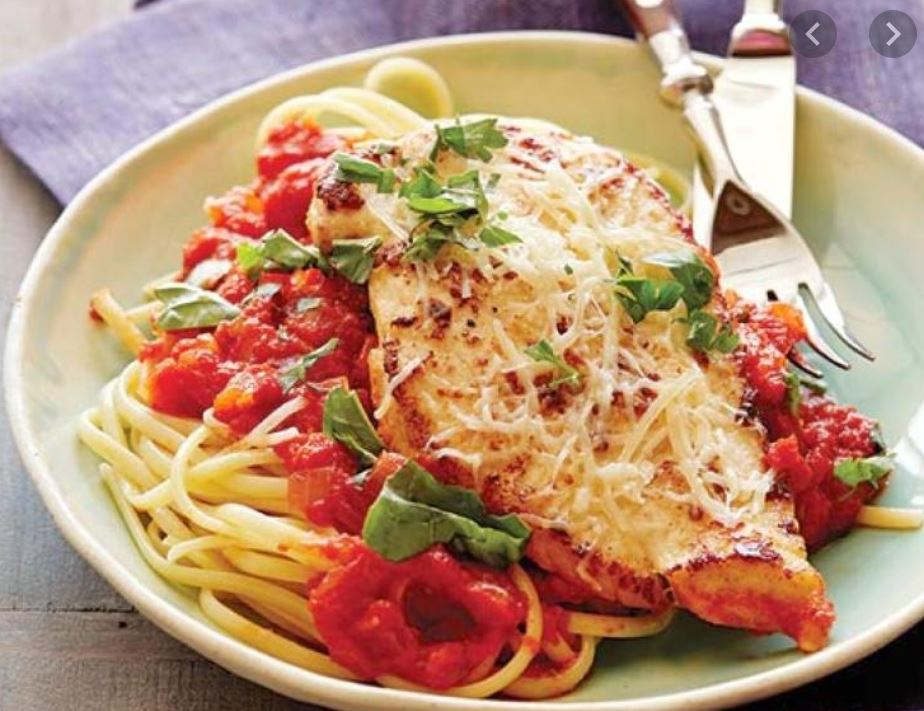Parmigiana is a classic Italian dish, Neapolitan in origin and humble in its simplicity.
Eggplant: This is where it all began: a simple vegetable dish topped with tomatoes and cheese, in a typically Southern Italian fashion. Though eggplant comes in dozens of colors, shapes, and sizes, the different varieties are interchangeable for parm-ing purposes, so long as the diameter isn’t so small that slices will be a pain to fry. Very large eggplant can be watery, so salt slices well and let them sit for an hour or so to give up their moisture before rinsing, drying, and proceeding with frying. All you need to do is fry slices in about a half inch of hot oil until both sides are golden, refreshing the oil in between batches. If you didn’t salt the eggplant before cooking, salt well after you fry.
The chicken or veal
Because Italian-American joints are on the wane (while more “authentic” Italian restaurants are proliferating), you’re better off cooking at home if you want good chicken or veal parm.
You’ll want a lot of surface area for crumbs, sauce, and cheese; thinness also makes for quick cooking. For chicken, you want boneless skinless chicken breasts, and for veal, buy cutlets. If what you come home with is more than 1/3-inch thick, you’ll have to pound. Place the meat between two sheets of plastic wrap and use the heaviest item in your kitchen (a glass jar or ceramic citrus juicer or whatever) and pound the meat until thin.
The breading
If you’re using chicken or veal, the next step is breading. (You can bread your eggplant if your tastes for melanzane veer towards the Italian-American; it’s just that you don’t have to, and it’s messy.) To keep those crumbs on, get three plates or shallow bowls. In the first, put flour. In the second, beat an egg. In the third, dump dried bread crumbs. Add salt and pepper to each. You can put some more seasonings in the bread crumbs, like red pepper flakes, oregano, dried basil, or grated parm.
To bread: Coat your first cutlet in the flour and shake off the excess. Transfer the meat to the egg, turning once to wet both sides. Finally, have your meat go for a dip in the bread crumbs, patting the coating onto any missed spots. Repeat with the remaining cutlets before frying them to a crisp.
The meatballs
You can make a good meatball for parm purposes by using meat, seasonings, and bread crumbs.
The frying
Despite the difference in breading, the frying stage of parm-making is quite similar, whether it’s eggplant or veal that’s in the pan. For both, you want about 1/2-inch of oil in a hot and a heavy pan set over medium-high heat; you’re ready to flip when the first side is golden and done when the second side is, around 5 minutes per side. Don’t crowd the pan. Eggplant absorbs an awful lot of oil, so you’ll want to keep adding oil in between batches so the pan doesn’t get dry.
The sauce
Your favorite marinara is the one to use. You’ll want sauce that has some chunks, for good texture and the ability to settle on top of your eggplant, chicken, or veal. To make a sauce from scratch, sauté a small onion in some olive oil until soft, then add a clove or two of minced garlic. Add a can of tomatoes (like San Marzano) and let the sauce simmer for around 20 minutes. Then, when you’re ready, top the chicken or veal with sauce. For the eggplant, layer sauce, eggplant, and cheese in a four-sided baking.
Some cooks likes to place a layer of tomato sauce on the bottom of a baking dish before placing the chicken or veal on top, but I think this leads to sogginess, so let’s avoid it. Instead, spoon sauce on top of each cutlet, before covering them with cheese.
The mozzarella
Because water’s not too much of a concern given all the tomato sauce in use here, you can opt for milky fresh mozzarella or the drier packaged stuff from the supermarket. Both work, as does a mix. Tear the mozz into bite-sized pieces for melting purposes. Use cheese sparingly if your style is Southern Italian; half a pound of mozz for two medium eggplants wouldn’t be too much if you want to show off the abundance of your Italian-American lifestyle. For chicken, a little cheese goes a long way, since any carefully breaded-and-fried pieces left exposed in the oven will end up extra crunchy (a good thing).
Baking
Baking serves different purposes in eggplant parm and chicken parm. For the eggplant, the heat of the oven helps the dish become one consistent casserole. The rich fried eggplant softens further, absorbing the flavor of the sauce. The cheese melts, binding the vegetables together. To make all this alchemy happen, cover the dish with foil, then bake in a 375°F oven for about 20 minutes. Remove the foil and keep in the oven another 10 minutes or so, until the cheese is nice and bubbly.
For the meat versions, the purpose of baking is simply to melt the cheese—though the heat also helps the cutlets stay crisp. Bake at 400°F for about 10 minutes, until the cheese is melted.
Applying the parmesan
You’ve got to douse the dish with freshly ground imported Parmesan cheese. You can apply parm at several states in the cooking process—in the breadcrumbs, or before the parm goes into the oven. But the crucial time is the moment immediately after you pull the baking pan from the heat. As soon as you can, sprinkle handfuls of parm on top of everything. The shreds will quickly melt, and the umami spark of the cheese will be the first taste you get on your tongue before the tomato, mozzarella, eggplant, or chicken even hit.


